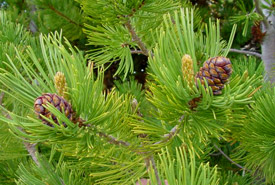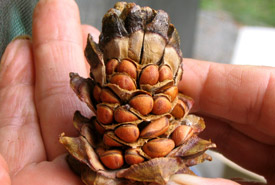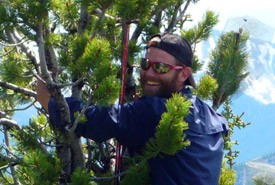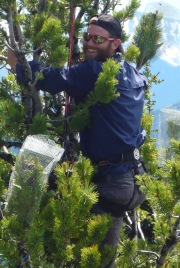Restoring an endangered tree species in the mountains of British Columbia

Whitebark pine needles and cones (Photo by Richard Sniezko)
In British Columbia, the majority of species at risk are found in low elevation areas where most private property is held. Most conservation properties held by the Nature Conservancy of Canada (NCC) are also found in these low elevation zones to protect high quality habitat for species at risk, among other things. An exception to this trend is the Darkwoods property, which is the largest private conservation property in Canada. Darkwoods covers 136,000 acres (55,000 hectares) in the West Kootenays and extends from the shore of Kootenay lake up to rugged peaks of the Selkirk Mountains.
Whitebark pine is an endangered tree species that is found at the highest elevation forests at the tops of the mountains in Darkwoods. It is a keystone species that produces very large seeds that are eaten by more than two dozen different bird and mammal species, including grizzly bears. Whitebark pine is threatened by a non-native disease called white pine blister rust, as well as mountain pine beetle and a changing climate.
Within Darkwoods, between 80 and 95 percent of all mature whitebark pines have already been killed by mountain pine beetles over the past 15 years, and about 65 percent of the remaining trees have been infected by white pine blister rust and are slowly dying.
The very large size of the Darkwoods property provides a rare opportunity to work to restore whitebark pine on a landscape scale. With funding from the Columbia Basin Trust and the Habitat Stewardship Program for Species at Risk (a program run by Environment Canada to contribute to the recovery of endangered species), we have been working on restoration efforts here since 2011.

Whitebark pine seeds in cones (Photo by Don Pigott)
There are several things that can be done to help ensure whitebark pine does not disappear from Darkwoods. The primary activity over the past three summers has been to collect cones from the few remaining healthy trees and either grow seedlings in greenhouses or plant the seeds directly in the ground. Healthy trees are selected because they may be genetically resistant to white pine blister rust. A very small proportion of whitebark pines do have some resistance to the blister rust, and the goal is to increase the number of these resistant individuals on the landscape.
There are many challenges in this type of work due to the harsh environment in which withebark pines grow. So much snow accumulates in these mountains over the winter that it does not typically melt until the start of July, and even in the summer a snowstorm can hit at any time. By the beginning of October, winter has already started and the snow starts to accumulate and access again becomes difficult. This leaves about three months to get as much work done as possible.

Adrian Leslie, Darkwoods project manager (Photo by Adrienne Shaw)
The cones grow on the tips of the uppermost branches of mature trees, and to collect them we must climb the tree with ropes and harnesses for safety. There are so many animals trying to get at the whitebark pine seeds as they mature that the trees must actually be climbed twice — once at the start of the summer when the cones are immature, to place small cages over the cones (to protect them from wildlife harvesting), and then again at the end of the summer to collect the mature cones.
The seeds are then extracted from the cones and either planted directly in the ground or sent to a greenhouse to be grown into seedlings large enough to survive once planted — a process that typically takes three years. In the summer of 2013 we planted several thousand seedlings and seeds collected in previous years from healthy trees on several mountain tops within Darkwoods. However, because they grow in such a harsh environment where the growing season is so short, they grow extremely slowly and won't really start producing cones for about 80 years.
This means that while we will continue to collect seeds and grow seedlings in the coming years, it will be up to our children and grandchildren to determine if all our hard work has really paid off and this beautiful and gnarly old tree species continues to survive and thrive in the Darkwoods conservation property.
For more information, please contact Adrian Leslie at adrian.whitebark@gmail.com.


